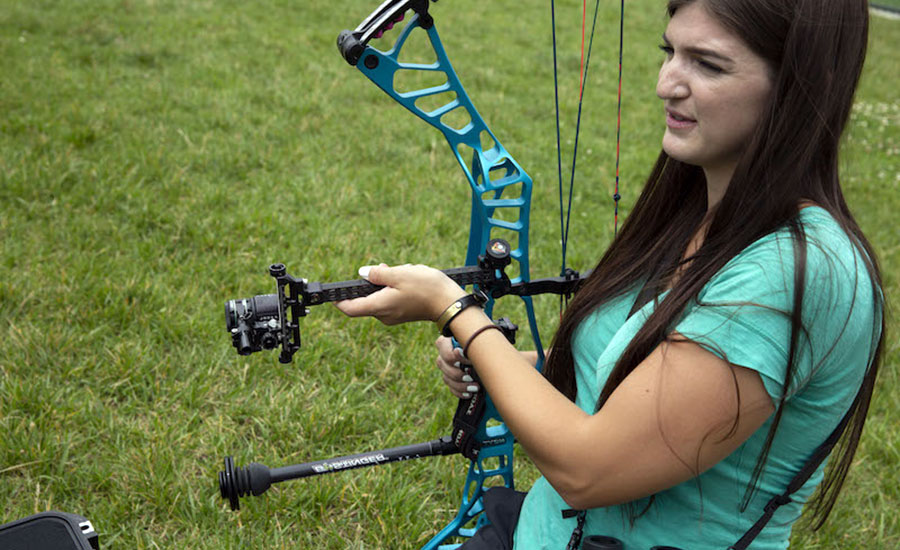Archery is a popular form of recreation for hunters. It is also popular for amateurs, especially those who want to scale up their archery skills on the desired range. It’s a bit tough to fit perfectly on the target with a typical weapon.
Apart from that, it is also tough to point your bow in a particular target. To be more precise, there is barely have a realistic hope of hitting the target perfectly.
The possibility of hitting the target would be higher owing to the process of sighting in a bow. Sighting in a bow also helps the archer to make up for arrow drop that can happen owing to the pull of gravity over distance and disturbances that can be happened due to the firing at the timing of aiming.
Before sitting in a bow, you need to consider the bow and range as well. Surely you want to expand your visibility in a few sessions. This is because fatigue affects its accuracy and effectiveness, and its shape is likely to change. Extending the sighting by a few days leads to greater accuracy.
Contents
Choose The Bow Sight:
1. Single Pin or Moveable Sights
Single pin sights are highly recommended for expert archers and hunters as well. In contrast to fixed pins, which offer distance sets of three to five, single pin sights are designed with only a pin. The entire housing unit is moved up or down to adjust it for the next shot.
One of the best things is that you can effectively adjust the single pin sight within seconds. Do not forget to put the white tape on the rear part of the sight. Then you can mark the distance depending on your needs, and you can use it whenever you want. Another thing we like about the single pin sig is that you can move the pointer depending on the situation of the current distance.
If you are a beginner and just want to get started, making larger marks for the enhancement of 5 or 10 yards distances would be an efficient idea for you. And then you will be able to make smaller marks in a particular range. Most importantly, you should use the bow sight that will improve your hunting accuracy at all.
2. Fixed Pin Sights
These sights are considered the most common option and offer three to five pins. If you fire a projectile up close, the top pin is used when pointing. You can use the lower pin for longer distances. We recommend configuring each pin individually before starting your next hunting adventure unless you know how to configure it in a short amount of time.
You only need to reach 3 0r 5 distances while configuring each pin. You know it’s pretty simple to remember. Most hunters do this in certain steps, but it depends on the type of hunt you do each time. We recommend staying in increments up to 5 or 10 yards.
Even though these are fixed pins, you can configure it yourself by pressing each pin. In fact, the hunters can reset the pins urgently when they need on the field. If you can estimate unknown distances well, this is an easy process. However, as your knowledge of this skill increases, some trial and error are required.
3. Treestand or Pendulum Sights
Shooting on the flat terrain, uneven terrain or elevated areas have some differences that the hunters know well. The latter requires a different kind of sight that compensates for these hard blows downhill. Most hunters spend more time on the ground than on trees, which is why it can be a little more difficult to assess these farms.
A pendulum sight can be used for precise shots. In this situation, multiple shots may be required to fully understand how these sights work, but only because the viewpoint pivots up and up to make amends for the strange angle. From the fixed and mobile goals, it is much different, therefore, it takes enough time to be consistent on this version before using it.
As most of these sights are not so well for shooting on uneven terrain, you have to make the decision appropriately. They are mainly engineered to help hunters with shots for short-range and descent angles as well. If you are not hunting in an elevated position, then this is not perfect for you. But surely it is important when you do hunting in an elevated position.
SIGHTING-IN
If you hit on the targeted point, move the body of your sight up. When it hits under the intended location, then try to move it down. If you hit to the left of the point, move the view body to the left. Move it to the right when you hit right to the point.
Personally, observing the speed of today’s bows, I wouldn’t recommend putting a pinless than 20 yards unless you’re an amateur archer with a slower arrow flight.
Once you have closed your 20-yard pin, return to 30 yards and repeat the process. Spend enough time to set this sight to 30 yards for hitting a 30-yard pin perfectly and precisely. By sliding the individual pins forward or backward, you can make up the distance between certain pins to get precision. Remember that you won’t touch the body of your sight anyway. Apart from that, you can’t set again the position of the 30-yard pin. Now the process is almost done. When your 20-yard pin hits in high, you need to move it up slightly. In contrast, you should move it down when it hits in low. Follow the same process for the 40-yard pin.
Spread the project for several days. The shape can change slightly from day today. For getting the best results, you will need to put the pins in the appropriate place over time. This has the effect that the recordings are averaged together. You can do five different practice hours to sight a bow perfectly.
CHOOSING THE ALIGNMENT SYSTEM
After you’ve sighted your bow more or less, it’s time to place and adjust your bow sight. No doubt you need something to provide a second alignment reference when you fire your bow. Just as a rifle would never consider firing his favorite weapon without sight, your bow also needs a sight.
You have options but I firmly believe in using a large peep sight. I will discuss now briefly why I do prefer to opt with a large peep sight. I have the feeling that a peep sight encloses me at my anchor point and ensures a visually aligned image better than other methods I have tried. I don’t like to combine many things with my bow. It’s very special to me. In fact, it could be the figurehead of a national by keeping it simple and stupid. This tendency prevents me from using some of the other systems on the market. However, as I mentioned, you have other options.
Some companies manufacture systems that comes with a traditional fiber optic pin and a rearward extension that serves as a sight. I’ve tried these and they definitely work, but they add complexity and weight to the bow. A positive note is that they do not need a peep sight at all and therefore improve their visibility and field of vision in poor lighting conditions.
Another option is the kisser button. A kiss button is also known as a small disc that can stick to the point on the rope. It also can interface your lips even touches the part of your mouth as sometimes it is fully stretched. The kiss also serves to improve visibility in low light and in the field of vision.
I only hunted on my rope with a kiss button and it works great with the short range of shots. To make the anchor point and the position of your body consistent and configured for shooting less than 30 yards, you have to practice frequently. Then the system will work well. But sometimes the kisser button works fantastic when I shoot for more than 30 yards. In fact, you can get more accurate shooting even without a rear sight if you use a kiss button.
Here, too, archery offers you the opportunity to tailor your equipment to your shooting style. You can start excellently with my recommendations, even you can improve it more from the starting point. Obviously I would get started with a peep sight if I don’t have strong objections to getting started with a cost-effective peep sight. You can change your system later at any time.
Installing a peep sight:
Make sure your peep sight is in the middle of the rope to prevent it from rotating dramatically as you pull the bow. When building ropes, the builder twists two different fiber bundles. You should have the capabilities to differentiate these two systems. In fact, there are two different colors are used in the string builder to instantly identify the center. By determining the canter, you can remove all chain tension from the last part. That’s why having a two-tone chain is important.
You should take the bow out of the trigger and put an arrow as well as remove it after placing the peep. Using tiny movements is the best way of aligning the fiber optic pin with your eyes when you set it to your desired anchor point.
Serve the peep when everything is aligned. I used to use a simply worn bowstring that is made out of wrapped thread material. Apart from that, I tie this bowstring in the same way in the middle section. Even though it is not so gorgeous, it’s fast and easy. More importantly, it gets stacked in the place.
Conclusion:
Before starting to rotate the tips, you should shoot the bow multiple times to fix the rope. If the peep always spins in the same way, you should remove one part of the bow with the bow pressing. You should also add the twist continuously until the tweet returns.
The process takes time. It may be a few days or a week to set and expand the rope. Once the process is done successfully, the peep will serve you for years.

